Riga, RISM, Līgo
Thursday, July 27, 2017
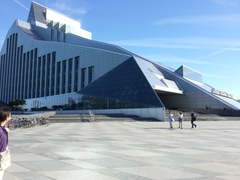
Four people from the RISM Central Office attended the annual IAML Congress in Riga, Latvia in June 2017. The following is a congress diary from all four participants that was originally published on the IAML website. In keeping with the Congress Diary tradition, the reflections are presented in the native languages of the writers. Here are two German and two American perspectives.
Klaus Keil: Opernsammlung in der Nationalbibliothek
Der Tagungsort, die Lettische Nationalbibliothek, ist ein imposantes Gebäude. Besonders beeindruckend ist der Blick aus dem 14. Stock, quasi ein Panorama der Stadt Riga.
Die Musikabteilung hält aber noch einen weiteren, leider noch ungehobenen Schatz. Hier werden ca. 30 Regalmeter Material aus dem ehemaligen Städtischen Deutschen Theater - heute Lettische Nationaloper - aufbewahrt. Es handelt sich um gedruckte und handgeschriebene Noten, Libretti, Theaterzettel.
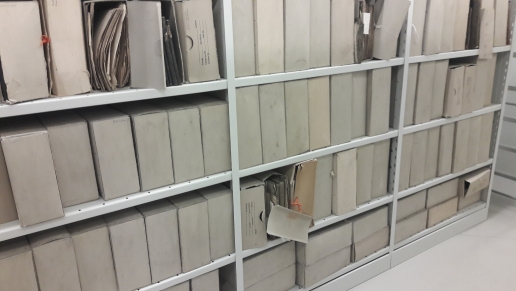
Photo: K. Keil
Mikus Čeže hat schon vor Jahren bei einer Konferenz des Instituts Deutsche Musikkultur im östlichen Europa an der Universität Bonn berichtet, dass dieser Bestand bei Umbauarbeiten hinter einem zugemauerten Treppenaufgang gefunden wurde.* Es dürfte sich also um Material aus dem 18. Jahrhundert handeln, das man zum Zeitpunkt des Umbaus nicht mehr brauchte. Rein zufällig bin ich auf einen gedruckten Klavierauszug der Oper „Il Matrimonio per Raggiro“ von Domenico Cimarosa (1749-1801) gestoßen, die hier offensichtlich in deutscher Fassung mit dem Titel „Die Heirat durch List“ vorliegt. Es ist ein weit verbreiteter Druck; bei RISM zu finden unter RISM ID no. 00000990009693 (A/I: C 2247).
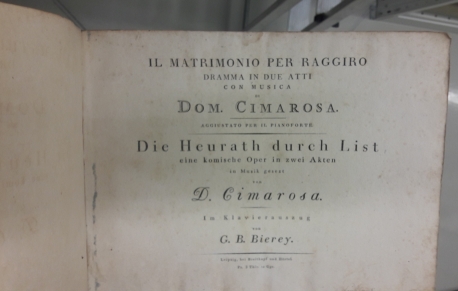
Photo: K. Keil
1882 brannte das Weisse Haus, das Gebäude in dem sich die Oper befindet, nieder. Der Bestand scheint das überstanden zu haben, doch sein Zustand ist heute nicht gut. Die Bibliothek hat alles in Kartons verpackt und verwahrt ihn unter optimalen Bedingungen. Dringend wäre eine Reinigung und ggf. Restaurierung erforderlich. Auch weiß derzeit niemand, was sich in den vielen Kisten verbirgt. Dem kann nur eine sorgsame Katalogisierung abhelfen.
Man könnte Aufschluss darüber erhalten, was in Riga – seit dem 19. Jahrhundert das Paris des Nordens genannt – bis ca. 1800 am Deutschen Theater gespielt wurde.
Ein anderer Lettischer Bestand, der von Liepājas Svētās Trīsvienības katedrāle (Evangelisch-Lutherische Dreifaltigkeitskirche Libau - LV-Lstk) wurde bereits bearbeitet und ist bei RISM nachgewiesen. Lolita Furmane (Riga) berichtete darüber bereits am Montag, 18. Juni.
*Mikus Čeže: Die Geschichte der Sammlungsbestände des Rigaer Stadttheaters. In: Berichte des Interkulturellen Forschungsprojektes „Deutsche Musikkultur im östlichen Europa“ Band 2: Musik-Sammlungen – Speicher interkultureller Prozesse. (Hrsg. Erik Fischer, Annelie Kürsten.) Stuttgart (Franz Steiner Verlag) 2007, S. 182-193.
Guido Kraus: Meine schönsten Erfahrungen in Riga
Nach mehreren nationalen IAML-Konferenzen nahm ich in diesem Jahr das erste Mal an einem aufregenden internationalen IAML-Kongress teil. Am Veranstaltungsort in der modernen Nationalbibliothek Lettlands fühlte ich mich sehr wohl. Dieses Bibliotheksgebäude ist einfach großartig. Es nimmt durch seine Lage am Unterlauf der Düna und durch seine Architektur einen besonderen Platz in der Rigaer Stadtlandschaft ein. Der Architekt ist Gunnar Birkerts. Er bezog sich in seiner Arbeit auf lettische Landschaften, die Kultur der Letten und ihre Märchenwelten.
Meine Teilnahme an den verschiedensten Sektionen war sehr inspirierend für mich. Ganz besonders gefielen mir die Vorträge in der Sektion „Musikalische Polonica in Moskauer Bibliotheken und Archiven“. Davon möchte ich den Vortrag von Frau Renata Suchowiejko besonders hervorheben. Sie sprach über die Musikbibliothek des Grafen Michał Kleofas Ogiński (1765-1833) im Moskauer Staatsarchiv. (NB: Ogiński war der Komponist der berühmten Polonaise „Abschied vom Vaterland“, die heute noch jedes Kind in Polen kennt.) Außerdem hatte ich die Ehre, auf der RISM-Sektion die Präsentation meiner Kollegin Agnieszka Drożdżewska, die leider nicht kommen konnte, vortragen zu dürfen. Ihr Thema war das polnische RISM-Projekt über historische Musiksammlungen in Niederschlesien aus Neisse, Oels, Oppeln und Breslau, das vom Musikwissenschaftlichen Institut an der Breslauer Universität erarbeitet wird. Daneben hatte ich mehrfach Gelegenheit, mit dem neuen IAML-Präsidenten Stanisław Hrabia zu sprechen. Ich bin sicher, seine Präsidentschaft wird für uns alle ein Gewinn sein. Ich freue mich jedenfalls schon auf die zukünftige Zusammenarbeit. Und: Nach dem Kongress ist vor dem Kongress. Bis bald in Leipzig.
Vivian Tompkins: Digitizing Music Materials
Many of the presentations at this year’s Congress focused on the digitization of music materials. A session dedicated to this theme, entitled “Digitisation Projects: Mozart, Bach and Contemporaries,” took place on Tuesday; the topic was also frequently addressed in other sessions throughout the week. The ongoing digitization projects presented at the Congress revolve around a diversity of materials and collections, including recordings from the sound archives in the Royal Library of Belgium (B-Br), the manuscript collection of Manfred Gorke (a current project of the Leipzig Bach Archive, D-LEb), and the “Mozart-Nachlass” in the Salzburg Mozarteum Foundation (A-Sm), among many others. The librarians and archivists who work on these digitization projects encounter many difficult decisions and challenges. Some of these challenges stem from considerations relating to the type of material that is being digitized. A clear example is the digitization of old sound recordings, since the digitized media should ideally reflect the original conditions in which the recording was created. Additionally, digitization projects are often hindered by a lack of funding. The engaging presentations given this year in Riga helped to shed further light on these and many other aspects of the digitization process.
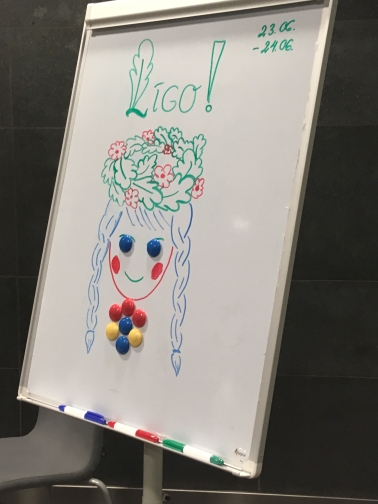
Photo: V. Tompkins
Jennifer Ward: Riga, City of Music
One of the aspects of Riga that will stay in my mind is how musical the city is. Apart from the congress itself, where we heard the acclaimed composer Ēriks Ešenvalds, the conductor Ints Teterovskis, and the State Choir LATVIJA, the city seemed to have music coming from every street corner. Some of the things I will remember:
- The buskers: two children playing recorders and one elderly woman playing a kokle
- The building that depicts lyres and a treble clef, clearly in Art Nouveau style (and way off the beaten track from our Wednesday afternoon Art Nouveau tour), modestly tucked among buildings that have seen better days
- The sculpture of the singers that stands at the entrance to the Mežaparks, which is also where the Song Festival takes place
- The plaque commemorating the theater where Richard Wagner was a music director (not far from the Rienzi Café)
- Visiting the Folkklubs Ala Pagrabs hoping to hear traditional Latvian music, but showing up on the only night of the month where they play traditional jazz
- A manuscript song collection in the Museum of the Occupation of Latvia which was written down by conductor Kārlis Deksnis during a forced resettlement period in Russia after being deported in 1949
- The cabinet containing Latvian folksongs collected by Krišjanis Barons (Verena Funtenberger wrote about this in her Congress Diary)
The perfect city for musicians.
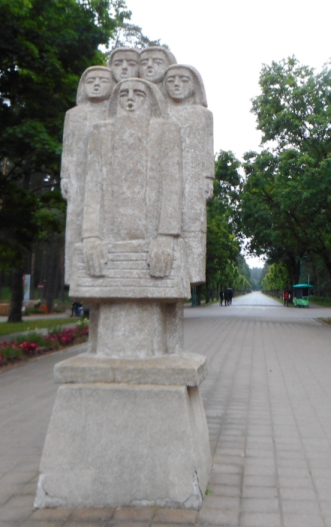
The entrance to the Mežaparks (photo: J. Ward)
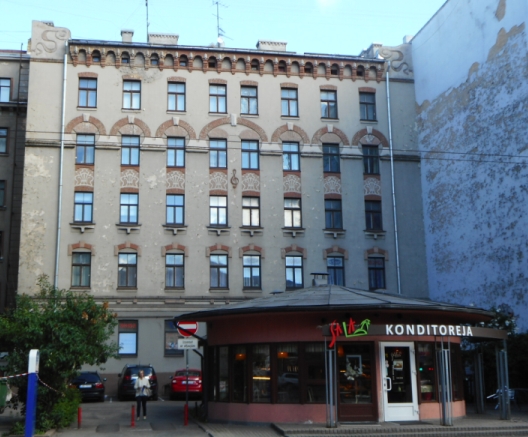
Art Nouveau off the beaten track (photo: J. Ward)
Catégorie: Evénements

